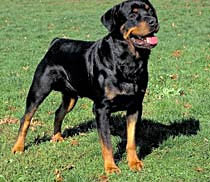|
The Canine Chronicles Directory
Rottweiler

Rottweilers have a double coat, with the medium length outer coat being coarse and
the under coat fine. The coat color is black with rust markings on the cheeks, chest,
lower legs, tail and above the eyes. The broad head has a well-defined stop, rounded
forehead and a well-developed occiput. The almond shaped eyes are dark brown and
medium in size. The high set, triangular ears are small, pendant and sit wide on
the head. The wide nose should be black. The inside of the mouth and lips should
also be black. The teeth should meet in a scissor-like bite. The long neck should
be slightly arched merging into well-laid back shoulders. The broad back should
have a slightly sloping croup and a level topline. The muscular legs should be straight
with well-bent stifles and strong hocks. The round feet should be compact with well-arched
toes. The strong tail is customarily docked and slightly carried above horizontal.
Rear dewclaws are customarily removed when the tail is docked.
|
|
Temperament
|
Rottweiler's are a calm, courageous, serious, and devoted breed. Their temperaments
may vary. They can be gregarious, outgoing and carefree while others are aloof,
independent and unsociable. This breed is intensely loyal to their families and
will defend them to the death. They need an owner who can handle their massive size,
but should be kept on a lead in public as they can be dog aggressive. Rottweiler's
have a tendency to become jealous if their owner's attention is focused elsewhere.
They have proven their worth countless times in police, military and customs work.
This breed should be chosen carefully and from a reputable breeder since the breed
can be naturally aggressive. Rotties do well in competitive obedience, schutzhund
and tracking.
|
|
Height, Weight
|
Male Height: 24-27" ; Weight: 95-130 lbs.
Female Height: 22-25" ; Weight: 85-115 lbs.
|
|
Health Problems
|
Rotties are prone to hip dysplasia, ACL damage and entropion. They tend to snore
and to overeat.
|
|
Living Conditions
|
Rottweiler's will do fine living in an apartment if they are sufficiently exercised.
They do best with a small to an average-sized yard.
|
|
Exercise
|
This breed needs plenty of exercise. They cannot get too much exercise since it
is what they thrive on. They love to chase balls and run free but they are not wanderers.
They love to swim and make perfect bicycling companions.
|
|
Life Expectancy
|
About 10-12 years
|
|
Grooming
|
The smooth, glossy coat of this breed is easy to care for. Brush or comb weekly
to remove dead hair and only bathe when necessary. This breed is an average shedder.
|
|
Origin
|
Although their history is unclear, the Rottweiler was thought to be a descendant
of mastiffs and to have been in existence since the early Roman Era. During this
time, they were supposedly used by the legions throughout their campaigns over the
Alps and into Europe. These dogs would hunt for wild boar as well as drive and guard
the livestock. If records can be found confirming this theory, then the Rottweiler
would have connections to the Swiss Mountain Dogs and the Entelbuchers. During the
Middle Ages, the Rottweiler was crossed with local sheepdogs in the town of Rottweil.
This dog was named Rottweiler Metzgerhund or the Rottweil Butcher's Dog. They would
assist butchers by driving cattle from town to town. Cattle driving became illegal
in Germany during the 19th century and the Rottweiler suffered a decline in the
popularity. In 1914, Rottweilers would be used for their physical strength and intelligence
during the first World War. The breed was eventually imported to the United States
during the 1930s. Rottweilers were recognized as a standardized breed by the AKC
in 1935, by the British Kennel Club in 1936 and by the United Kennel Club in 1950.
Today, this breed is used as police and guard dogs.
|
|
Group
|
AKC Working, UKC Guardian Dog
|